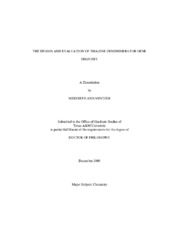| dc.description.abstract | The interest in using gene therapy to target a variety of both inherited and
acquired diseases has intensified over the last two decades. Because free DNA is easily
degraded by serum nucleases in the bloodstream, the need for developing carrier systems
that can compact and protect the DNA was quickly realized. Viral vector systems were
some of the earliest carriers used, primarily because of the ease with which such systems
can infect host cells. However, difficulties experienced when using viral vectors,
including immunogenicity and the potential for genetic recombinations, forced
researchers to design alternative delivery strategies. Non-viral vectors offer one
alternative to overcome this dilemma. In addition to avoiding the biological problems
experienced using viral carriers, non-viral vectors also offer the potential for large-scale
production. Dendrimers are one non-viral carrier that has shown appreciable ability to
deliver DNA into cells, a process called transfection. In the past, triazine dendrimers
have shown biocompatibility, and the ability to synthesize these structures to contain
cationic charges on the surface makes these structures potentially suitable for
transfection studies.
In this study, a small library of triazine dendrimers was synthesized in an attempt
to understand how variations to both the periphery and core of triazine dendrimers affect
the transfection efficiency of these dendriplexes. In the first subset of structures, a
common core was used and various peripheral groups were appended to the dendrimer
surface. The physicochemical and biological data, obtained in collaboration with
Thomas Kissel at Philipps-Universitat Marburg, showed that the surface groups have a
notable affect on transfection efficiency. Dendrimers with a higher amine number and
neutral surface groups show high DNA binding affinity and higher transfection
efficiency. In the second subset of dendrimers, variations to the core showed that
transfection efficiency is improved both by increasing generation number and dendrimer
flexibility.
With this data in hand, triazine dendrimers with both higher generation number
and higher flexibility have been synthesized. Two different triazine linker groups,
trimethylene-dipiperidine and polyglycoldiamine, have been used. These structures will
be evaluated to determine if increasing both flexibility and generation number together
can further improve transfection efficiency. | en |


